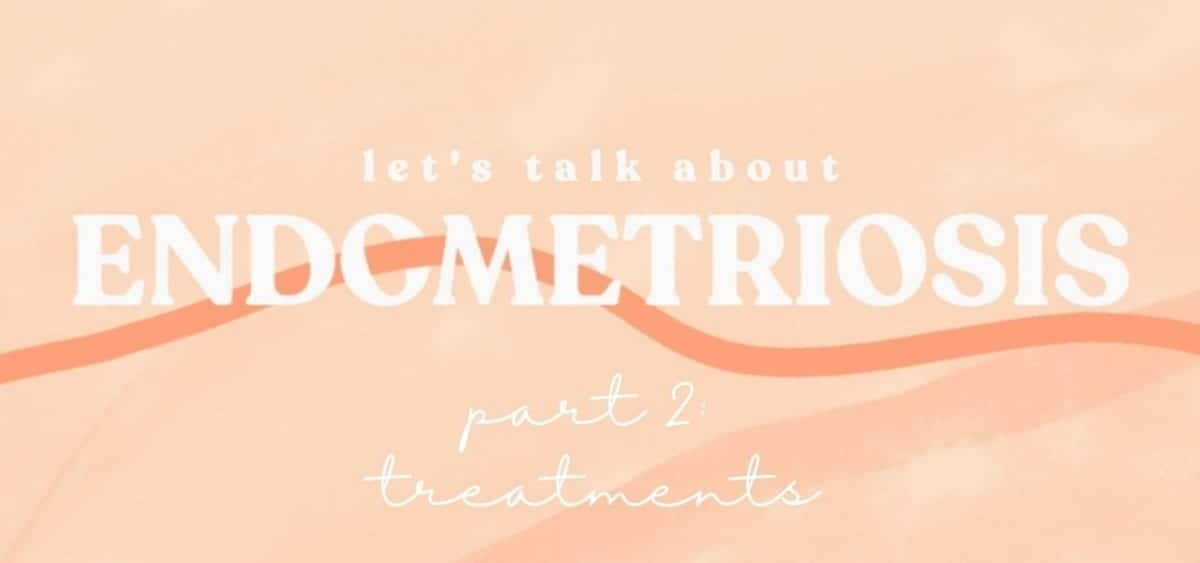Home > Hormones > Hormone issues & symptoms > Endometriosis Series: Treatments


This is the second instalment of the Endometriosis series, so if you haven’t already, please go and check out my first post on what Endometriosis is here!
In this post I will outline some of the main treatment options for Endometriosis.
Unfortunately I have to say that there is no cure for Endometriosis, therefore treatments are used to lessen symptoms and improve quality of life.
Of course these are not your only options and therefore I would strongly advise you consult your GP or a healthcare professional, preferably an endometriosis specialist on which route to take.
One of the main symptoms of Endometriosis (and one of the more debilitating ones) is pain. This pain, as I described in my last post, can be period related or general. Most commonly, the pain radiates from the stomach and back, although it can affect other areas of the body.
Over-the-counter pain medications such as ibuprofen and paracetamol can help manage the pain. However, these may not work for some. If this is the case then a visit to the GP or a healthcare professional will help you decide whether you need stronger or more effective medications.
With pain medication it is important to adhere to the required dosage as well as ensure that you are not taking any medications which could negatively affect each other. Before committing to pain medication it is important to get a healthcare professional’s opinion.
Taking hormone supplements can help your body regulate your varying hormone levels. This can help relieve pain as well as slow the progression of the condition.
Although this treatment is unable to stop the progression of Endometriosis entirely.
There are a few different types of hormone therapy. One of the more well known treatments is ‘Gonadotrophin-releasing hormone’ (GnRH). This therapy causes the tissue growth to shrink, while lowering your oestrogen levels and halting your menstrual cycle. Upon stopping the therapy, your menstrual cycle and fertility returns.
If this sounds like something you would like to try then you should contact your GP and they will be able to advise you on the best course of action.
Contraceptives such as birth control tablets, vaginal insertions and even patches can help regulate Endometriosis. This is done through the regulation of menstruation and reduction in fertility, thus limiting the growth of Endometriosis tissue.
While this treatment can be very effective, it is not helpful for those who suffer the condition who are trying to get pregnant. In this case you should try and find an alternative treatment which does not decrease your fertility.
Alongside this your GP may advise against using contraceptives to regulate your menstrual cycle as some contraceptives can have negative side effects for those who suffer from migraines or other underlying health conditions. It is very important to inform your GP of any health conditions which may be affected by taking medication.
Endometriosis can lead to difficulties in getting pregnant. If this is the case then your GP may recommend fertility treatment.
These can be a variety of treatments such as in vitro fertilisation (IVF) or stimulating your ovaries in order to produce more eggs.
This is one of the more extreme treatments of Endometriosis. In the surgery, the tissue growths are removed while preserving your uterus and ovaries. This can increase chances of pregnancy as well as reducing pain associated with the condition. Although the tissue growths and the pain may return.
This is a treatment which must be talked over with a healthcare professional before agreeing to the procedure.
This is probably the most extreme treatment of Endometriosis. However it is not used as much now as medical professionals tend to treat the symptoms and remove the tissue instead.
Hysterectomy is the removal of the uterus. Oophorectomy is the removal of the ovaries.
Removing these organs in surgery results in the menopause. This can reduce and even eradicate pain, although endometriosis can remain. With the menopause other health implications can begin such as cardiovascular diseases and metabolic conditions.
You do not have to have both surgeries as improvements can be seen in those who undergo only one.
This is a big step as this prevents pregnancy entirely and can have other health implications. This treatment must be talked over with a doctor before considering it.
Endometriosis can be a very limiting condition. However with the right treatments it can be managed. Talk over your options with a medical professional you trust and it is always advisable to get a second opinion before committing to a treatment.
I hope this has helped outline some of the available treatments for Endometriosis.
Source: NHS Endometriosis

-


Dr Singh is the Medical Director of the Indiana Sleep Center. His research and clinical practice focuses on the myriad of sleep.

How do you know when your ovulation is over? Ovulation is a key part of a woman’s menstrual cycle, but what is it, and what are the signs you already ovulated? The first step is understanding how ovulation occurs and

What is anovulation? As we discussed earlier, anovulation is when the ovaries fail to release a mature egg during the menstrual cycle. Many women experience at least one anovulatory period during their lifetime, but if you chronically have no ovulation

Does ovulation make you more horny? When considering the question, “Does ovulating make you horny?” the answer comes from the body’s biological functions during the menstrual cycle. As we touched on earlier, there are two phases in a woman’s menstrual
Hormona© 2024, All Rights Reserved
| Cookie | Duration | Description |
|---|---|---|
| cookielawinfo-checkbox-analytics | 11 months | This cookie is set by GDPR Cookie Consent plugin. The cookie is used to store the user consent for the cookies in the category "Analytics". |
| cookielawinfo-checkbox-functional | 11 months | The cookie is set by GDPR cookie consent to record the user consent for the cookies in the category "Functional". |
| cookielawinfo-checkbox-necessary | 11 months | This cookie is set by GDPR Cookie Consent plugin. The cookies is used to store the user consent for the cookies in the category "Necessary". |
| cookielawinfo-checkbox-others | 11 months | This cookie is set by GDPR Cookie Consent plugin. The cookie is used to store the user consent for the cookies in the category "Other. |
| cookielawinfo-checkbox-performance | 11 months | This cookie is set by GDPR Cookie Consent plugin. The cookie is used to store the user consent for the cookies in the category "Performance". |
| viewed_cookie_policy | 11 months | The cookie is set by the GDPR Cookie Consent plugin and is used to store whether or not user has consented to the use of cookies. It does not store any personal data. |

Say hello to Hormone Support, a daily supplement designed to address the most common hormonal symptoms tracked in our app.